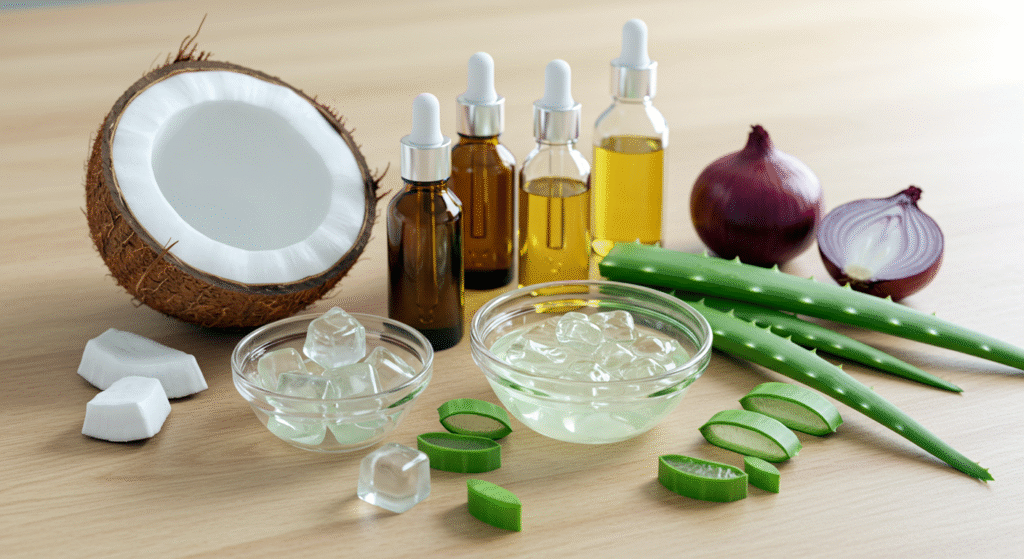Why Healthy Hair Growth Feels Like a Mystery
Let’s be honest: everyone dreams of that effortless “good hair day”—shiny, thick, and healthy strands flowing with confidence. But when hair feels brittle, sheds faster than we’d like, or refuses to grow past a certain length, frustration sets in. Suddenly, you’re deep in online forums, staring at bottles that promise miraculous results, and wondering which routine actually works.
Here’s the secret: healthy hair growth isn’t about a magic shampoo or an overnight trick (sorry internet hacks). It’s about consistent habits, scalp-friendly routines, and nourishing your body from the inside out. Think of it like tending to a garden—you can’t force plants to shoot up, but with the right care, soil, and sunlight, growth thrives naturally.
In this ultimate guide, you’ll learn tried-and-true hair care tips backed by science and stylist-approved wisdom: from scalp treatments that encourage follicles to wake up, to nutrition tips, to styling habits that won’t sabotage your strands. By the end, you’ll have a practical game plan for strong, thriving locks that don’t just look good but are healthy from root to tip.
What Are the Core Factors Behind Healthy Hair Growth?
Before diving into hacks and routines, let’s break down the fundamentals that influence whether your hair grows thick and strong—or becomes weak and stagnant.
- Genetics – Determines natural growth rate, texture, and density.
- Diet & Nutrition – Hair is made of protein (keratin), so your nutritional intake has a significant effect.
- Scalp Health – A clogged, irritated, or unbalanced scalp environment slows growth.
- Hormones & Stress – Imbalances or elevated stress can trigger shedding.
- Hair Care Practices – Over-processing, heat, and harsh habits weaken strands.
Think of these like the “pillars” of hair health. You can’t change your DNA, but you can optimize every other factor to influence visible growth and resilience.
How Can You Take Care of Your Scalp for Faster Growth?
Your scalp is like the soil where hair grows—ignore it, and strands struggle. Nurture it, and you unlock ideal growth conditions.
1. Keep Scalp Clean, But Not Stripped
- Wash 2–3 times per week for balance.
- Use sulfate-free shampoos to prevent dryness and irritation.
- Clarify once a month with a gentle exfoliating scrub or apple cider vinegar rinse to remove buildup and excess oils.
2. Massage and Boost Circulation
- Daily scalp massages (5 minutes) can improve blood flow, bringing oxygen and nutrients to follicles.
- Using essential oils like rosemary or peppermint (diluted in carrier oil) has been linked to stimulating growth.
3. Treat Dandruff and Flakes Promptly
- Fungal imbalance or dryness can clog follicles.
- Opt for zinc pyrithione or tea tree-based shampoos if flakes persist.
Pro Tip: Treat your scalp like premium skin care—cleanse, exfoliate, nourish. Happy scalp = thriving hair.
What Nutrients Are Essential for Stronger Hair?
Healthy hair literally grows from within. No topical product can replace what your body lacks internally.
Key Nutrients for Hair Growth
- Protein – Hair’s building block (lean meats, eggs, legumes).
- Biotin (B7) – Supports keratin infrastructure (almonds, sweet potatoes).
- Vitamin D – Deficiency linked to hair shedding (sunlight, fortified dairy).
- Iron – Low levels often cause thinning (spinach, red meat, lentils).
- Zinc – Helps follicle function and repair (pumpkin seeds, chickpeas).
- Omega-3 Fatty Acids – Keeps hair supple and scalp hydrated (salmon, chia seeds).
Practical Eating Tips
- Build meals with protein + colorful veggies + healthy fats.
- Stay hydrated—dehydration shows up as dry, brittle hair.
- Supplements can help but should complement (not replace) a balanced diet.
Are There Hairstyles and Habits That Protect Growth?
Yes! What you do daily can make or break your strands.
Healthy Styling Habits
- Use a wide-tooth comb on wet hair to avoid breakage.
- Sleep on a silk pillowcase to reduce friction.
- Limit high-tension styles (tight buns, ponytails, braids). These can cause traction alopecia over time.
Heat Styling Rules
- Always apply a heat protectant spray.
- Keep tools under 350°F (180°C).
- Limit to 1–2 times weekly for minimal damage.
Protective Styles
Braids, twists, and buns can guard against environmental damage—just make sure they’re not too tight or left in too long without scalp care.
Which Natural Remedies Actually Support Hair Growth?
Natural remedies are popular, but not all are backed by evidence. Here are ones worth considering:
| Remedy | How It Helps | Best Use Method |
|---|---|---|
| Rosemary Oil | May stimulate follicles | Mix a few drops with jojoba oil, massage |
| Aloe Vera | Soothes scalp, hydrates hair | Apply gel as scalp mask |
| Onion Juice | High in sulfur, shown to regrow hair | Apply as mask (smelly but effective) |
| Green Tea Rinse | Rich in antioxidants | Rinse hair post-shampoo |
How Do Stress and Sleep Impact Hair Growth?
- High stress → elevated cortisol → hair shifts to “shedding” phase.
- Poor sleep → reduced cell regeneration, slower growth.
Practical Fixes
- Daily stress relief: meditation, yoga, journaling.
- 7–8 hours of quality sleep each night.
- Regular exercise to balance hormones and improve circulation.
Hair Care Routine for Healthy Growth (Step-by-Step)
Here’s a sample weekly routine that combines all the tips above:
- Daily – Gentle scalp massage, hydration, silk pillowcase sleep.
- Every 2–3 days – Wash with sulfate-free shampoo, condition mid-lengths to ends.
- Weekly – Deep condition or apply nourishing hair mask.
- Monthly – Clarify scalp and trim split ends.
- Seasonally – Re-assess needs based on weather (e.g., more hydration in winter).
FAQs:
Q1. How fast does hair usually grow per month?
On average, hair grows about ½ inch (1.25 cm) per month, or roughly 6 inches (15 cm) per year. Genetics and lifestyle can speed or slow this.
Q2. Can trimming hair make it grow faster?
Trimming doesn’t affect follicle speed, but it prevents split ends from traveling upward—so hair looks healthier and grows longer without breakage.
Q3. Which oil is best for hair growth?
Rosemary and castor oils are popular for stimulating scalps, while coconut oil is best for reducing protein loss.
Q4. Why is my hair thinning suddenly?
Possible reasons include stress, nutritional deficiencies, hormonal changes, or medical conditions like thyroid issues. A doctor or dermatologist should evaluate sudden changes.
Q5. What is the best shampoo for hair growth?
Look for shampoos free from sulfates and silicones, enriched with biotin, niacin, or natural oils to support a healthier scalp environment.
Q6. Can supplements alone regrow hair?
Supplements can fill nutrient gaps, but results depend on overall lifestyle. They work best alongside a healthy diet and scalp routine.
Conclusion: Unlocking Healthy Hair Growth that Lasts
Achieving healthy, thriving hair is less about miracle serums and more about consistency, care, and balance. By treating your scalp like skin, nourishing your body with the right nutrients, adopting protective styling habits, and weaving in natural remedies, you give your strands the conditions they need to grow longer, stronger, and shinier.
The real magic? Small daily habits have compounding effects. Just as a garden flourishes when watered regularly, your hair blossoms with the care you give it over time. Start with one or two of these tips today, stay consistent, and soon those “good hair days” will become your everyday.
👉 Found these tips helpful? Share this guide with a friend, or try one new strategy this week and watch your healthy hair journey unfold.

